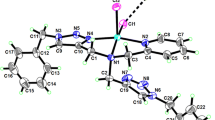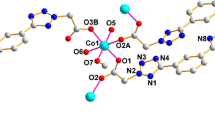Abstract
A novel tripodand-type ligand (L1) having three 2,3-dihydroxynaphthalene end groups and a C3 symmetric 1,3,5-tryimethylbenzene based backbone was prepared by the reaction of 1,3,5-tris(bromomethyl)-2,4,6-trimethylbenzene with 3-(2-(hydroxymethyl)allyloxy)naphthalene-2-ol followed by triple Claisen rearrangement. A 1:1 titanium complex which acts as a metallo-cryptand is obtained by the reaction of ligand (L1) with Ti(IV)(=O)(acac)2 in the presence of base. The formation of the metallo-cryptand strongly depends on templating effects by counter cations and it shows a high selectively for the encapsulation of cesium cations in its cavity.





Similar content being viewed by others
References
(a) Lehn, J.-M.: Supramolecular Chemistry-concepts and Perspectives. VCH, Weinheim, (1995); (b) Vögtle, F.: Supramolekulare Chemie. Teubner, Stuttgart (1992); (c) Philip, D., Stoddart, J. F.: Self-assembly in natural and unnatural systems. Angew. Chem. Int. Ed. Engl. 35, 1154–1196 (1996); (d) Steed, J. W., Atwood, J. L.: Supramolecular Chemistry. Wiley, New York (2000); (e) Albrecht, M., Fröhlich, R.: Symmetry driven self-assembly of metallo-supramolecular architectures. Bull. Chem. Soc. Jpn. 80, 797–808 (2007)
(a) Caudler, D. L., Raymond, K. N.: Superamolecular self-recognition and self-assembly in Gallium(III) catecholamide triple helices. Angew. Chem. Int. Ed. Engl. 36, 1440–1442 (1997); (b) Meyer, M., Kersting, B., Powers, R. E., Raymond, K. N.: Rearrangement reactions in dinuclear triple helicates. Inorg. Chem. 36, 5179–5191 (1997); (c) Enemark, E. J., Stack, T. D. P.: Synthesis and structural characterization of a stereospecific dinuclear Gallium triple helix: use of the trans-influence in metal-assisted self-assembly. Angew. Chem. Int. Ed. Engl. 34, 996–998 (1995); (d) Albrecht, M.: How do they know? Influencing relative stereochemistry of the complex units of dinuclear triple-stranded helicate-type complexes. Chem. Eur. J. 6, 3485–3489 (2000); (e) Johnson, D. W., Raymond, K. N.: The role of guest molecules in the self-assembly of metal-ligand Clusters. Supramolecular Chem. 13, 639–659 (2001); (f) Albrecht, M., Schneider, M.: Dinuclear triple-stranded helicates from rigid oligo-p-phenyleneligands: self-assembly and ligand self-recognition. Eur. J. Inorg. Chem. 2002, 1301 (2002); (g) Albrecht, M., Janser, I., Houjou, H., Fröhlich, R.: Long-range stereocontrol in the self-assembly of two-nanometer dimensional triple-stranded dinuclear helicates. Chem. Eur. J. 10, 2839–2850 (2004); (h) Piguet, C., Bernardinelli, G., Hopfgartner, G.: Helicates as versatile supramolecular complexes. Chem. Rev. 97, 2005–2062 (1997); (i) Albrecht, M.: Let's twist again – Double-stranded, triple-stranded, and circular helicates. Chem. Rev. 101, 3457–3498 (2001); (j) Fiedler, D., Leung, D. H., Bergman, R. G., Raymond, K. N.: Selective molecular recognition, C-H bond activation, and catalysis in nanoscale reaction vessels. Acc. Chem. Res. 38, 349–358 (2005)
For metallo-cryptands see, for example (a) Akine, S., Taniguchi, T., Saiki, T., Nabeshima, T.: Ca2+- and Ba2+-selective receptors based on site-selective transmetalation of multinuclear polyoxime-zinc(II) complexes. J. Am. Chem. Soc. 127, 540–541 (2005); (b) Akine, T., Matsumoto, T., Taniguchi, T., Nabeshima, T.: Synthesis, structures, and magnetic properties of tri- and dinuclear Copper(II)-Gadolinium(III) complexes of linear oligooxime ligands. Inorg. Chem. 44, 3270–3274 (2005); (c) Saalfrank, R. W., Burak, R., Breit, A., Stalke, D., Herbst-Irmer, R., Daub, J., Porsch, M., Bill, E., Muether, M., Trautwein, A.X.: Mixed-valence, tetranuclear iron chelate complexes as endoreceptors: charge compensation through inclusion of cations. Angew. Chem. Int. Ed. Engl. 33, 1621–1623 (1994); (d) Graf, E., Hosseini, M. W., DeCian, A., Fischer, J.: Simultaneous binding of boron and alkaline metal cations by a macrocyclic ligand bearing catechol units: structural analysis of borocryptates. Bull. Chem. Soc. Fr. 133, 743–748 (1996); (e) Saalfrank, R. W., Dresel, A., Seitz, V., Trummer, S., Hampel, F., Teichert, M., Stalke, D., Stadler, C., Daub, J., Schuenemann, V., Trautwein, A. X.: Topologic equivalents of coronands, cryptands and their inclusion complexes: synthesis, structure and properties of {2}-metallacryptands and {2}-metallacryptates. Chem. Eur. J. 3, 2058–2062 (1997)
For metallo-macrocycles see, for example (a) Saalfrank, R. W., Loew, R. W. N., Hampel, F., Stachel, H.-D.: The first metallacrown ether sandwich complex. Angew. Chem. Int. Ed. Engl. 35, 2209–2210 (1996); (b) Stemmler, A. J., Barwinski, A., Baldwin, M. J., Young, V., Pecoraro, V.: Facile preparation of face differentiated, chiral 15-metallacrown-5 complexes. J. Am. Chem. Soc. 118, 11962–11963 (1996); (c) Stemmler, A. J., Kampf, J. W., Pecoraro, V. L.: A planar [15]metallacrown-5 that selectively binds the uranyl cation. Angew. Chem. Int. Ed. Engl. 35, 2841–2843 (1996)
(a) Amoroso, A. J., Jefferey, J. C., Jones, P. L., McCleverty, J. A., Thornton, P., Ward, M. D.: Self-assembly of a ferromagnetically coupled manganese(II) tetramer. Angew. Chem. Int. Ed. 34, 1443–1446 (1995); (b) Brückner, C., Powers, R. E., Raymond, K. N.: Symmetry-driven rational design of a tetrahedral supramolecular Ti4L4 cluster. Angew. Chem. Int. Ed. 37, 1837–1839 (1998); (c) Saalfrank, R. W., Glaser, H., Demleitner, B., Hampel, F., Chowdhry, M. M., Schünemann, V., Trautwein, A. X., Vaughan, G. B. M., Yeh, R., Davis, A. V., Raymond, K. N.: Self-assembly of tetrahedral and trigonal antiprismatic clusters [Fe4(L4)4] and [Fe6(L5)6] on the basis of trigonal tris-bidentate chelators. Chem. Eur. J. 8, 493–497 (2001); (d) Albrecht, M., Janser, I., Meyer, S., Weis, P., Fröhlich, R.: A metallosupramolecular tetrahedron with a huge internal cavity. Chem. Commun. 2854–2855 (2003); (e) Lützen, A.: Self-assembled molecular capsules – Even more than nano-sized reaction vessels. Angew. Chem. Int. Ed. 44, 1000–1002 (2005)
(a) “The Biological Chemistry of Iron,” ed by H. D. Dunford, D. Dolphin, K. N. Raymond, L. Sieker. D. Reidel Publishing Co., Dordrecht (1981); (b) Stintzi, A., Raymond, K. N.: In: Templeton, D. E.: (ed.) Molecular and Cellular Iron Transport, pp. 273–319. Marcel Dekker, New York (2001)
(a) Hiratani, K., Takahashi, T., Kasuga, K., Sugihara, H., Fujiwara, K., Ohashi, K.: Double claisen rearrangement: a new route to novel ligands for metal ions. Tetrahedron Lett. 36, 5567–5570 (1995); (b) Hiratani, K., Kasuga, K., Goto, M., Uzawa, H.: Tandem claisen rearrangement: a novel, one-step synthesis of calixarene analogues from macrocyclic polyethers. J. Am. Chem. Soc., 119, 12677–12678 (1997)
(a) Hayashi, M., Hiratani, K., Kina, S., Ishii, M., Saigo, K.: Synthesis and binding property of a novel tripodal hexadentate ligand having catechol moieties. Tetrahedron Lett. 39, 6211–6214 (1998); (b) Hayashi, M., Ishii, M., Hiratani, K., Saigo, K.: Synthesis and binding properties of new tripodal hexadentate ligands having three quinolinol moieties for trivalent metal cations. Tetrahedron Lett. 39, 6215–6218 (1998)
Suzuki, M., Yoshida, S., Shiraga, K., Saegusa, T.: New ring-opening polymerization via a-allylpalladium complex. 5. Multibranching polymerization of cyclic carbamate to produce hyperbranched dendritic polyamine. Macromolecules 31, 1716–1719 (1998)
Nagawa, Y., Fukazawa, N., Suga, J., Horn, M., Tokuhisa, H., Hiratani, K., Watanabe, K.: Stepwise synthesis of crownophanes having either one or two hydroxy groups via Claisen rearrangement. Tetrahedron Lett. 41, 9261–9265 (2000)
Albrecht, M., Janser, I., Runsink, J., Raabe, G., Weis, P., Fröhlich, R.: Selecting different complexes from a dynamic combinatorial library of coordination compounds. Angew. Chem. Int. Ed. 43, 6662–6666 (2004)
Acknowledgement
Financial support by the DAAD for an exchange scholarship for S. B. and support by the Deutsche Forschungsgemeinschaft (Schwerpunktprogramm 1118) is gratefully acknowledged. We would also like to thank Dr. Masatoshi Kanesato at National Institute of Advanced Industrial Science and Technology, Tsukuba, Japan for helpful discussion on the ESI mass spectrometry. One of the authors (K.H.) thanks the Ministry of Education, Culture, Sports, Science and Technology (MEST) for partial support through a Grant-in-Aid for Scientific Research (No. 19550132).
Author information
Authors and Affiliations
Corresponding author
Rights and permissions
About this article
Cite this article
Burk, S., Albrecht, M. & Hiratani, K. Selective inclusion of cesium ion in a cryptand-type Ti(IV) complex derived from a tripodal tris-2,3-dihydroxynaphthalene ligand. J Incl Phenom Macrocycl Chem 61, 353–359 (2008). https://doi.org/10.1007/s10847-008-9429-1
Received:
Accepted:
Published:
Issue Date:
DOI: https://doi.org/10.1007/s10847-008-9429-1




